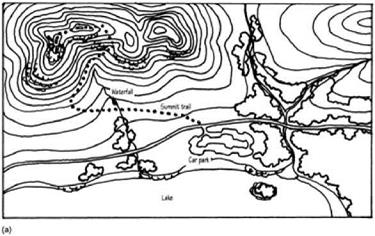There are some basic features of any message: it should be short, to the point, and should use as many symbols, pictures, maps and diagrams as possible instead of words.
A map or maps showing the area being visited, the immediate site and any other smaller areas within the main area, such as a trail or special feature, are vital. Scales should be chosen to show sufficient detail and context without taking up too much room. A main map at 1:50000, 1:25000, 1:20000 or 1:10000 for larger areas, or 1:5000, 1:2500 or 1:1250 for smaller ones, may be presented, with inset details at larger scales. The cartography should be to the highest standard, with a linear scale, a north point, and an indicator of where the information panel is. Contours, roads and paths, forest and open areas, cliffs, viewpoints, rivers and lakes, buildings, boundaries and special features such as archaeological sites should be shown.
There is wide evidence to suggest that many people have difficulty in reading maps, even those of a high standard. The three-dimensional ‘landscape view’ map is often easier to interpret for many, and should be considered as an option.
The detailed site area should show the layout of car parks, toilets, picnic areas, the start of trails, play areas, water, boat launches etc. This might be diagrammatic or pictorial rather than cartographic in style.
In all cases, landscape features should be named, but most other features shown should use standard symbols as far as possible. The library of international symbols for different
|
|
|
(a) A generalized layout of an information panel using a map. Some people find such maps difficult to understand. (b) The same layout using pictorial information is more accessible to many people, who can gauge the scale of the landscape and a sense of its three-dimensional form. |
places, activities, safety instructions and so on is now extensive and well used. Its use reduces the space required, and minimizes the need for translation into foreign languages.
Other information might concern the various activities possible in the area. This can combine pictures depicting these with short descriptions. Path or trail conditions, suitability for disabled people, recommended footwear, or anticipated duration would be the kind of information to give about a hiking trail, for example.
Information of a temporary nature might also be provided, such as fire danger rating, expected weather or water conditions, recently seen wildlife, warning of theft, lost property, work in the woods and so on. These can be posted daily in a special area.
Finally, the chance to welcome visitors and to ask for their comments is always useful. A phone number, a contact person or an address to write to can be provided. This gives unmanned sites a human touch, and offers some reassurance to those visitors apprehensive of wild places that they are looked after





